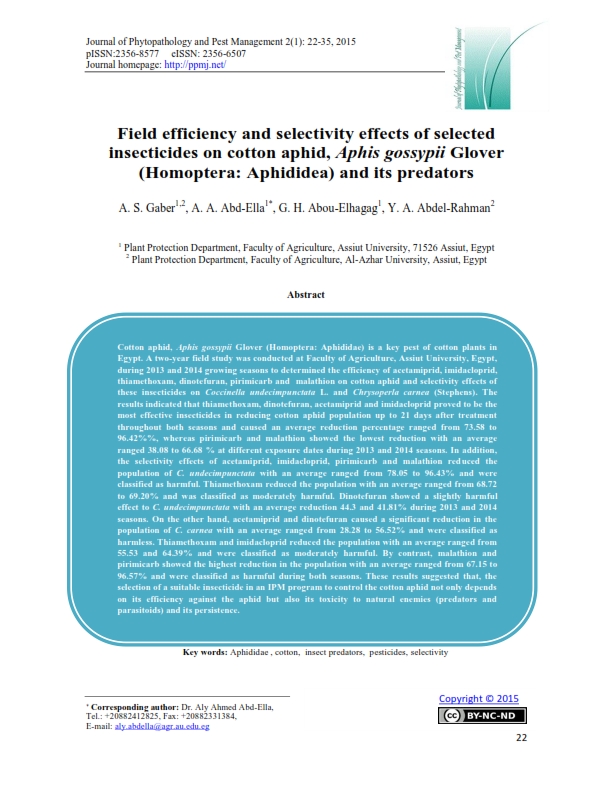Field efficiency and selectivity effects of selected insecticides on cotton aphid, Aphis gossypii Glover (Homoptera: Aphididea) and its predators
Keywords:
Aphididae, cotton, insect predators, pesticides, selectivityAbstract
Cotton aphid, Aphis gossypii Glover (Homoptera: Aphididae) is a key pest of cotton plants in Egypt. A two-year field study was conducted at Faculty of Agriculture, Assiut University, Egypt, during 2013 and 2014 growing seasons to determined the efficiency of acetamiprid, imidacloprid, thiamethoxam, dinotefuran, pirimicarb and malathion on cotton aphid and selectivity effects of these insecticides on Coccinella undecimpunctata L. and Chrysoperla carnea (Stephens). The results indicated that thiamethoxam, dinotefuran, acetamiprid and imidacloprid proved to be the most effective insecticides in reducing cotton aphid population up to 21 days after treatment throughout both seasons and caused an average reduction percentage ranged from 73.58 to 96.42%%, whereas pirimicarb and malathion showed the lowest reduction with an average ranged 38.08 to 66.68 % at different exposure dates during 2013 and 2014 seasons. In addition, the selectivity effects of acetamiprid, imidacloprid, pirimicarb and malathion reduced the population of C. undecimpunctata with an average ranged from 78.05 to 96.43% and were classified as harmful. Thiamethoxam reduced the population with an average ranged from 68.72 to 69.20% and was classified as moderately harmful. Dinotefuran showed a slightly harmful effect to C. undecimpunctata with an average reduction 44.3 and 41.81% during 2013 and 2014 seasons. On the other hand, acetamiprid and dinotefuran caused a significant reduction in the population of C. carnea with an average ranged from 28.28 to 56.52% and were classified as harmless. Thiamethoxam and imidacloprid reduced the population with an average ranged from 55.53 and 64.39% and were classified as moderately harmful. By contrast, malathion and pirimicarb showed the highest reduction in the population with an average ranged from 67.15 to 96.57% and were classified as harmful during both seasons. These results suggested that, the selection of a suitable insecticide in an IPM program to control the cotton aphid not only depends on its efficiency against the aphid but also its toxicity to natural enemies (predators and parasitoids) and its persistence.
Metrics

Published
How to Cite
Issue
Section
License
Authors who publish with Journal of Phytopathology and Disease Management agree to the following terms:
- Authors retain copyright and grant the journal right of first publication with the work simultaneously licensed under a Creative Commons Attribution License that allows others to share the work with an acknowledgement of the work's authorship and initial publication in this journal.
- Authors retain copyright and grant the journal right of first publication with the work simultaneously licensed under the Creative Commons Attribution-Non Commercial License (CC BY-NC). This allows others to share the work with an acknowledgement of the work's authorship and initial publication in this journal.
- Archives of Agricultural Sciences Journal is an Open Access Journal, and articles published are distributed under the terms of the Creative Commons Attribution-Non Commercial License (CC BY-NC). Readers may copy, distribute, and display the work for non commercial purposes with the proper citation of the original work. However, the journal retains the right to exploit subsidiary rights on behalf of the authors.
- Authors are able to enter into separate, additional contractural arrangements for the non-exclusive distribution of the journal's published version of the work (e.g. post it to an institutional repository or publish it in a book), with an acknowledgement of its initial publication in this journal.
- Authors are permitted and encouraged to post their work online (e.g., in institutional repositories or on their website) prior to and during the submission process with full disclosure to the journal, as it can lead to productive exchanges, as well as earlier and greater citation of published work. Following publication in Archives of Agricultural Sciences Journal, the author should update the repository, and include a citation and link to the published work.
Click here for more information on Licensing policy
.png)




